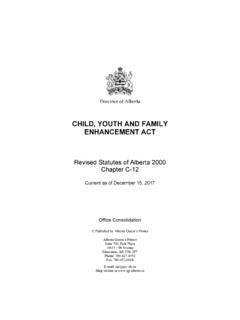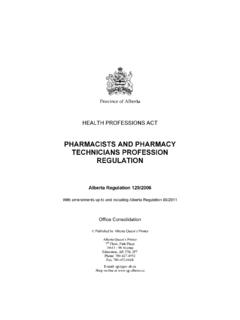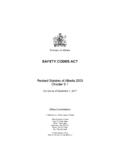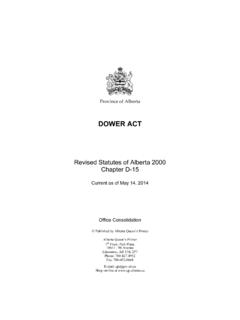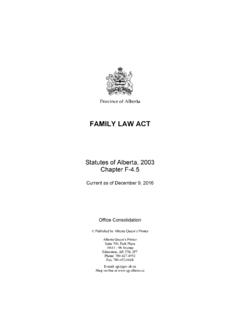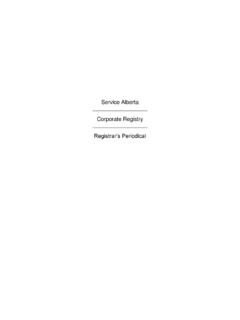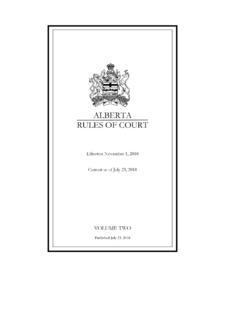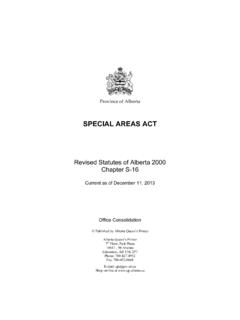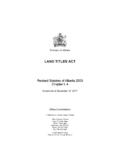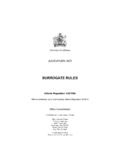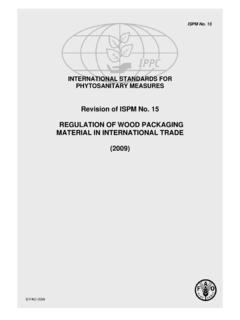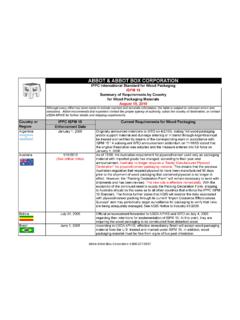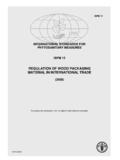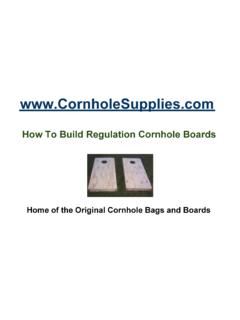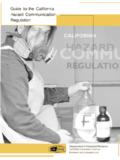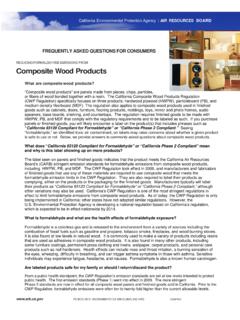Transcription of ENVIRONMENTAL PROTECTION AND ENHANCEMENT ACT
1 Province of A lberta Office Consolidation Alberta Regulation 192/1996 With amendments up to and including Alberta Regulation 62/2013 ENVIRONMENTAL PROTECTION AND ENHANCEMENT ACT WASTE CONTROL REGULATION Published by Alberta Queen s Printer E-mail: Shop on-line at Alberta Queen s Printer 7th Floor, Park Plaza 10611 - 98 Avenue Edmonton, AB T5K 2P7 Phone: 780-427-4952 Fax: 780-452-0668 Copyright and Permission Statement Alberta Queen's Printer holds copyright on behalf of the Government of Alberta in right of Her Majesty the Queen for all Government of Alberta legislation. Alberta Queen's Printer permits any person to reproduce Alberta s statutes and regulations without seeking permission and without charge, provided due diligence is exercised to ensure the accuracy of the materials produced, and Crown copyright is acknowledged in the following format: Alberta Queen's Printer, 20__.
2 * *The year of first publication of the legal materials is to be completed. Note All persons making use of this consolidation are reminded that it has no legislative sanction, that amendments have been embodied for convenience of reference only. The official Statutes and regulations should be consulted for all purposes of interpreting and applying the law. (Consolidated up to 62/2013) ALBERTA REGULATION 192/96 ENVIRONMENTAL PROTECTION and ENHANCEMENT Act WASTE CONTROL REGULATION Table of Contents 1 Definitions Part 1 Hazardous Waste 2 Definitions 3 Personal identification numbers Generator s duties 4 Exemption 5 Form of manifest 6 Manifest completion 7 Generator s and consignor s manifest duties 8 Carrier s manifest duties 9 Receiver s manifest duties 10 Multiple carriers manifests 11 Storing hazardous waste 12 Storage of PCBs 13 Landfills 14 Codes of practice 15 Importation 16 Dilution or division Part Hazardous substances Hazardous substances Part 2 Hazardous Recyclables 17 Application 18 Storage 19 Recycle docket 20 Information
3 21 Importation Section 1 AR 192/96 WASTE CONTROL REGULATION 2 Part 3 Non-hazardous Waste 22 Application 23 Prohibition 24 General 25 Certified operators 26 Burning Part 4 Security 27 Security required 28 Amount of security 29 Adjustment of security 30 Form of security 31 Return of security 32 Retention of security 33 Forfeiture of security Part 5 Miscellaneous 34 Expanded definition of waste 35 Form of order 36 Review of EPO Part 6 General 38 Standards for compost facilities 39 Records 40 Plans and reports 41 Waste collection containers 42 Offences 43 Due diligence 44 Transition 45 Repeal 46 Coming into force Schedules Definitions 1 In this Regulation, Section 1 AR 192/96 WASTE CONTROL REGULATION 3 (a) Act means the ENVIRONMENTAL PROTECTION and ENHANCEMENT Act; (b) agricultural waste means waste generated by a farmer; (c) biomedical waste means waste that is generated by (i) human health care facilities, (ii) medical research and teaching establishments, (iii) clinical testing or research laboratories, and (iv) facilities involved in the production or testing of vaccines, and contains or may contain pathogenic agents that may cause disease in humans exposed to the waste; (d) certified operator means a person who holds a valid certificate of qualification issued in accordance with the Act and this Regulation.
4 (e) Class I compost facility means a waste management facility where waste, not including hazardous waste, is decomposed through a controlled bio-oxidation process, including a thermophilic phase, that results in a stable humus-like material, but does not include (i) a residential composter, (ii) a compost facility that receives only sludge as defined in the Wastewater and Storm Drainage Regulation (AR 119/93), (iii) a Class II compost facility, or (iv) a manure storage facility as defined in the Agricultural Operation Practices Act; (f) Class II compost facility means a waste management facility where only vegetative matter or manure is decomposed through a controlled bio-oxidation process, including a thermophilic phase, that results in a stable humus-like material, but does not include (i) a residential composter, or (ii) a manure storage facility as defined in the Agricultural Operation Practices Act; Section 1 AR 192/96 WASTE CONTROL REGULATION 4 (g) Class I landfill means a landfill for the disposal of waste that has (i) 2 liners of which at least one is a synthetic liner, (ii) a leachate collection and removal system, (iii) a leak detection system between the 2 liners, and (iv) a groundwater monitoring system; (h), (i) repealed AR 162/2005 s2.
5 (j) Class II landfill means a landfill for the disposal of waste, not including hazardous waste; (k) Class III landfill means a landfill for the disposal of inert waste; (l) repealed AR 162/2005 s2; (m) container means any portable device which is or was used to store or hold hazardous waste or dangerous goods; ( ) dangerous goods means a product, substance or organism that is by its nature or by the regulations under the Transportation of Dangerous Goods Act, 1992 (Canada) included in any of the classes listed in the Schedule to that Act; (n) Director means the person designated as Director for the purposes of this Regulation; (o) dispersible form means any of the following or a mixture of them: (i) a liquid; (ii) a solid that can pass through a mm mesh opening; (iii) a friable solid that can be reduced by grinding in a mortar and pestle to a particle size that can pass through a mm mesh opening; (p) dispose , when used with respect to waste at a landfill or by deepwell injection, means the intentional placement of waste on or in land as its final resting place; (q) empty container means a container that contains less than centimetres of the original contents or less than 3% of the original contents, whichever is the lesser amount; Section 1 AR 192/96 WASTE CONTROL REGULATION 5 (r) farmer means a person engaged in an agricultural operation as defined in the Agricultural Operation Practices Act.
6 (s) Federal regulations means the Transportation of Dangerous Goods regulations (SOR/2001-286) made under the Transportation of Dangerous Goods Act, 1992 (Canada); (t) hazardous recyclable means a recyclable that has one or more of the properties described in Schedule 1; (u) hazardous recyclable facility means a facility for storing or processing hazardous recyclables; (v) hazardous waste means waste that has one or more of the properties described in Schedule 1, but does not include those wastes listed in Schedule 2; (w) hazardous waste management facility means a facility for the collection, storage, treatment or disposal of hazardous waste, but does not include an on-site facility; ( ) inert waste means solid waste that, when disposed of in a landfill or re-used, is not reasonably expected to undergo physical, chemical or biological changes to such an extent as to produce substances that may cause an adverse effect, and includes, but is not limited to, demolition debris, concrete, asphalt, glass, ceramic materials, scrap metal and dry timber or wood that has not been chemically treated; (x) internal volume means the nominal capacity of a container.
7 (y) land treatment means (i) the controlled application of a substance on the land surface and the incorporation of the substance into the upper soil zone, (ii) the controlled application of soil containing hydrocarbons on the land surface, with or without incorporation of the soil containing hydrocarbons into the upper soil zone, or (iii) the controlled application of soil containing hydrocarbons onto a man-made surface or containment system, Section 1 AR 192/96 WASTE CONTROL REGULATION 6 in such a manner that physical, chemical or biological removal or degradation of the substance or hydrocarbons takes place, but does not include (iv) the controlled application to land of sludge as defined in the Wastewater and Storm Drainage Regulation (AR 119/93), or (v) the controlled application of a substance to land where that activity constitutes an agricultural operation as defined in the Agricultural Operation Practices Act; (z) landfill means a waste management facility at which waste is disposed of by placing it on or in land, but does not include a land treatment facility, a surface impoundment, a salt cavern or a disposal well; (aa) liquid , when used with respect to waste, means a waste that has free liquids; (bb) oil production site means the field production facilities for recovering oil or oil sands by drilling or other in-situ recovery methods, including any injection or pumping facilities, and any associated infrastructure, where the site is located within the area illustrated in the guideline entitled Guide for Oil Production Sites published by the Department.
8 (cc) oilfield waste means an unwanted substance or mixture of substances that results from the construction, operation, abandonment or reclamation of a facility, well site or pipeline within the meaning of the Oil and Gas Conservation Act and the regulations under that Act but does not include an unwanted substance or mixture of substances from such a source that is received for storage, treatment, disposal or recycling at a facility authorized for that activity pursuant to the ENVIRONMENTAL PROTECTION and ENHANCEMENT Act; (dd) oilfield waste management facility means a facility that is approved under the Oil and Gas Conservation Act and the regulations under that Act to process, treat, dispose of, store or recycle oilfield waste; (ee) on-site facility means a facility that is used solely to deal with wastes or recyclables generated on property that is owned, rented or leased by the person responsible for the facility; Section 1 AR 192/96 WASTE CONTROL REGULATION 7 (ff) person responsible for a facility of any kind under this Regulation means (i) the owner or previous owner of the facility, (ii) every person who has or has had charge, management or control of the facility or any portion of the facility, (iii) any successor, assignee, executor, administrator, receiver, receiver-manager or trustee of a person referred to in subclause (i) or (ii), and (iv) a person who acts as a principal or agent of a person referred to in subclauses (i), (ii) or (iii).
9 (gg) recyclable means a substance or mixture of substances that is intended to be recycled; (hh) residential composter means a composter that (i) is located at a residence, (ii) is used to decompose manure, food scraps or vegetative matter resulting from gardening, horticulture, landscaping or land clearing, and (iii) uses a controlled bio-oxidation process that results in a stable humus-like material; ( ) soil containing hydrocarbons means soil that is contaminated with only gasoline, kerosene, jet fuel or diesel fuel, or any combination of them; (ii) storage site means a waste management facility, where waste, other than hazardous waste, is (i) stored, (ii) sorted, compacted, shredded, ground or processed, or (iii) collected and held for removal to another waste management facility; (jj) surface impoundment means a facility that consists of an excavation or diked areas that is formed primarily of earthen material and is used for the storage of waste.
10 ( ) TEQ means dioxin toxic equivalent with respect to the following toxicity equivalency factors: Section 2 AR 192/96 WASTE CONTROL REGULATION 8 Congener Toxicity equivalency factor 2,3,7, 1,2,3,7, 1,2,3,4,7, 1,2,3,6,7, 1,2,3,7,8, 2,3,7, 1,2,3,7, 2,3,4,7, 1,2,3,4,7, 1,2,3,6,7, 1,2,3,7,8, 2,3,4,6,7, (kk) unrinsed empty container means an empty container that previously held a hazardous waste (i) that has not been rinsed 3 times, using for each rinse a clean solvent that is in an amount equal to 10% of the container volume and that is capable of removing the previously co
